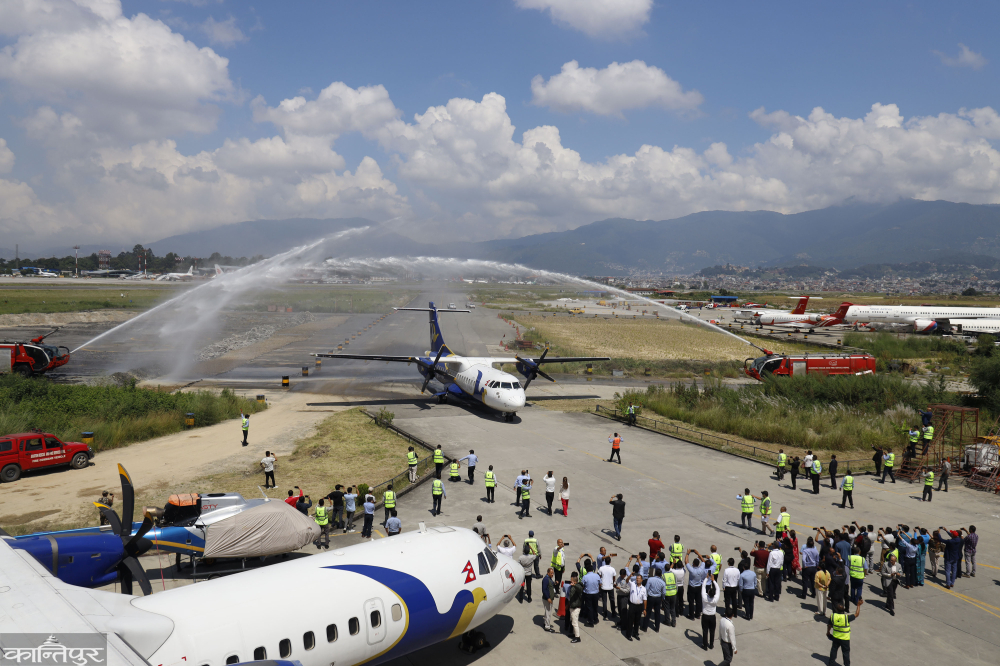Ships are old, therefore retired

We use Google Cloud Translation Services. Google requires we provide the following disclaimer relating to use of this service:
This service may contain translations powered by Google. Google disclaims all warranties related to the translations, expressed or implied, including any warranties of accuracy, reliability, and any implied warranties of merchantability, fitness for a particular purpose, and noninfringement.

Highlights
- The aviation policy of Nepal itself says that when importing ships larger than 19 seats, they should not be more than 15 years old or 45,000 bicycles, similarly, when importing small ships, they should not be more than 20 years old.



Nepal is infamous in countries that are a tourist resource destination due to plane crashes that cause financial loss every year. The European Union (EU) has not yet lifted the ban on Nepalese airlines entering its 27 member countries for 11 years.

On Tuesday, while the air sector was being defamed, the Nepali Airlines company and its technicians conveyed a happy message to the world that 'the plane can be operated properly!' The news related to ATR aircraft is happening for the first time in Nepal's aviation history, it was also a 'first' for the outside world.
Budh Air, the leading private sector airline company in Nepal, said goodbye to its first ATR-42 aircraft from commercial flight forever after completing 70,000 flights (one take-off-landing). This 47-seat ATR aircraft, which was jointly produced in France and Italy, first debuted in the Nepalese skies 16 years ago on 22 August 2065 as a 'second-hand' aircraft.
According to the data of the ATR company, it has produced around 1,000 aircraft of this model so far. About 250 of them are currently in active service around the world. That ATR of MSN No. 403 was the first for Buddha. According to Nepali dates, it made its first flight in August 2052 for Air Caledonia in Europe.

Before entering the Nepalese skies, the aircraft had completed 25,000 cycles (flights) in the skies of Europe in 13 years. A grand ceremony was held at the Tribhuvan International Airport to bid farewell to the aircraft that flew for 12,588 hours in the Nepali skies and served around 1.8 million passengers. Large fire trucks of the airport were placed on both sides and salute was given by throwing water fountains from both sides. Such salutes are not normally given to ships in aviation. It's like a red carpet for ships.
According to Birendra Bahadur Basnet, Executive Chairman of Buddha Air, saying that such a farewell to complete 70,000 cycles in a commercial flight is the first time not only in Nepal but also in the world, representatives from ATR's Asia Pacific Regional Office in Singapore including Pawan Tanwani came to witness this historic moment.
 In addition, the deputy head of the French Embassy in Nepal, Yalsa Cali, the head of the safety standards department of the regulatory body Nepal Civil Aviation Authority, Prabhakarchandra Mallik, the director of Kathmandu Airport, Rinji Sherpa, the CEO of the Tourism Board, Deepakraj Joshi, the president of the Air Service Operators Association, Manoj Karki, the president of the Hotel Association of Nepal, Vinayak Shah, Skull International Nepal President Mahendra Poudel, Himalaya Bank CEO Ashok Rana, who provided continuous financial support to Buddha in the purchase of the ship, along with heads/representatives of more than two dozen tourism-related organizations that brought Buddha to this height, waved goodbye to the ship.
In addition, the deputy head of the French Embassy in Nepal, Yalsa Cali, the head of the safety standards department of the regulatory body Nepal Civil Aviation Authority, Prabhakarchandra Mallik, the director of Kathmandu Airport, Rinji Sherpa, the CEO of the Tourism Board, Deepakraj Joshi, the president of the Air Service Operators Association, Manoj Karki, the president of the Hotel Association of Nepal, Vinayak Shah, Skull International Nepal President Mahendra Poudel, Himalaya Bank CEO Ashok Rana, who provided continuous financial support to Buddha in the purchase of the ship, along with heads/representatives of more than two dozen tourism-related organizations that brought Buddha to this height, waved goodbye to the ship.
Captain Sovan Basnet and co-pilot Avinash Kharel made the last mountain flight from Kathmandu before the departure of the ship. The ship, carrying 20 distinguished passengers including hostesses Legislature Koirala and Manjali Thapa, was shown the mountain ranges including Mount Everest. The ATR with the registration 'Nine November-Alpha India November', returning to Kathmandu from Dhaulagiri in the north-west to Everest in the east, rested both its wings after completing its last flight.
After the plane landed, the crew did not drop the passengers at the domestic parking lot and brought them from the middle runway to the hangar of Buddha Air in the northeast and brought the passengers who went on the mountain flight to a farewell ceremony. Along with those passengers, the ship also turned into a guest of the show. After a certain number of landings, i.e. 70,000 cycles, the air frame of the aircraft weakens due to exposure to sun, water, wind, digging of the runway, etc. Mangesh Thapa, director of Buddha Air, said that according to this rule, Buddha said goodbye to this aircraft from his ship-family.
This ATR-42 aircraft is the first in the world to be parted from a commercial flight, the representative of ATR's regional office in Singapore, Pawan Tanwani, also said at the ceremony. He praised Budha's technicians saying that Nepali Airlines companies are among the MRO companies of the developed nation in maintenance and flight operations of ATR aircraft. Engineer Thapa said that after purchasing a 'brand new' ship in other countries, the cycle is not completed, selling it to the airline company of the third country, changing it to cargo, and because the old ship gets stuck and gets scrapped after the airline company goes into financial crisis, Engineer Thapa said that this model of ship got a chance to fly completely commercially.
 ATR company has produced thousands of ships so far. Buddha said that this incident is the first time that an aircraft has passed the full operational period of an ATR ship. According to Thapa, a mechanical engineer who has been with Buddha Air's engineering department for 26 years, the age of an ATR aircraft is determined by the number of flights it has landed. Therefore, the age of the ship is not based on weeks, days, years. After each flight has completed a certain number of landings, maintenance and replacement of parts is required. No more than the cycle specified by the aircraft manufacturer may be flown. Then the ship has to say goodbye.
ATR company has produced thousands of ships so far. Buddha said that this incident is the first time that an aircraft has passed the full operational period of an ATR ship. According to Thapa, a mechanical engineer who has been with Buddha Air's engineering department for 26 years, the age of an ATR aircraft is determined by the number of flights it has landed. Therefore, the age of the ship is not based on weeks, days, years. After each flight has completed a certain number of landings, maintenance and replacement of parts is required. No more than the cycle specified by the aircraft manufacturer may be flown. Then the ship has to say goodbye.
Buddha's executive president Basnet said that the usable parts of this plane will be removed and its airframe will be handed over to the fire station at Tribhuvan International Airport for aviation exercises. Buddha Air has inducted 18 ATR aircraft in 16 years. Which airline is also the seventh largest airline in the world in flying the most ATR aircraft.
It entered service with brand-new American Beechcraft-1900-D aircraft in October 054 before flying the ATR. Buddha brought up to 7 of the 19-seat Beechcraft C and D. Now the Buddha does not have those small ships. In February 2079, it sold the last two Beechcraft 1900-Cs to a Canadian airline. The age of this type of ship is not specified. Guna Airlines currently has two Beechcraft vessels of this type. They are currently not in flight as the company is closed.
The life of the ship's structure (fuselage) can be 'expanded' from the parts of the American plane Beechcraft in Nepal's domestic flight and the Canadian Twinwater with Nepal Air Service Corporation and Tara Air and the German-developed Dornier aircraft with Sita Air. 80,000 flight cycles of CRJ and Bombardier planes with Shree Airlines flying on easy routes for domestic flights have been set. After reaching 80,000, Shri should bid farewell to those ships too, like Buddha, from commercial flights.
The structure of 19-seat small aircrafts in domestic flights can also be changed according to the standards of the manufacturing company," said Prabhakarchandra Mallik, director of the flight safety department, which regulates the airworthiness of aircraft in Nepal, "according to the specified age of all the parts of Twinotter, Dornier, Beechcraft aircraft, the flight cycle, hours, According to him, the wing cycle of the Dornier aircraft is fixed. According to a Dornier pilot, after reaching 36,000 cycles, the wings of the Dornier aircraft should be replaced. While Budha is pulling the 29-year-old aircraft from the flight on the basis of 70,000 cycles, on the other hand, two 40-year-old twin-engines of Nepal Airlines Corporation are flying from Kathmandu to Bhojpur and Tumlingtar on a domestic flight.
According to aviation experts, there is no exact age limit for any aircraft. The age of an aircraft used in commercial flight depends on its type, use and how well it has been maintained. Aircraft in developed countries are often 'retired' after 20-30 years of service in commercial aviation. Then those planes are purchased and operated by third country airlines that do not have much income in cargo flights or aviation business like Nepal. American airlines Delta, United and American Airlines fly an average of 12 to 14 years after purchasing a brand-new aircraft. Then they sell to other low-cost carriers (airline companies) and third country companies.
As the ship gets older, its repair schedule and replacement of spare parts become faster and more expensive, so big companies prefer buying a new ship instead of increasing the burden of maintenance expenses. Regulatory bodies such as the United States' Federal Aviation Administration (FAA), the European Union's Aviation Safety Agency (EASA), which are known around the world in aviation regulation, have set standards for the maintenance and safety of all types of ships. However, he also did not specify the exact age of the ship's 'retirement'.
According to the leading flight newspaper 'Flight International', some of the world's airlines are operating old aircraft in excellent condition. The only reason for this depends on how well the ship is maintained. According to FlightRadar24, a World War II-era Douglas DC-3 is still flying. The DC3, which first flew 88 years ago in 1936, is considered by aviators to be a powerful aircraft. Now the number of DC-3 in flight is very few.
Some countries have preserved this variant in museums. DC-3 has difficulty in flights to high mountains and valleys. Satellite-based tracking technology has not been developed for the DC-3 while flying into the mountains. But now DC-3 has 136 flights in America, 38 in Canada, 16 in Australia, 5 in UK, 2 in Holland, 136 flights each in Sweden, Finland, Denmark, Switzerland, Hungary, New Zealand and South Africa.
The DC-3 is able to fly in the sky because the parts needed for these planes are still being produced, according to FlightRadar in the blog. When there are plane crashes in Nepal, the general public criticizes the government saying that the accidents happened because the 'Thotra' ship was allowed to fly.
2012 August 14, 2012 Since the first Douglas DC-3 plane crash in Simra, 69 years after the accident, investigations have been conducted. According to the Authority's Safety Management Division, most of the reports of the commission of inquiry formed by the government after the accident did not show that the accident was due to the aircraft being too short.
The authority has kept all accident investigation reports since 2008. He did not point out that the ship was old or too small to cause the accident,” said a safety management inspector of the authority. According to Riteshraj Pant, manager of flight safety standards department, no part of an aircraft has an exact age. The ship manufacturing company has specified the life of each ship. That life depends on the basis of the flight cycle, hours, calendar (month/year) which is calculated on the basis of flight/landing," he said, "besides that, the parts used in the ship also have three types of 'life'. It depends on how many cycles or how many hours/months/years when changing those parts.'
Nepal Airlines Corporation and Tara Air are the first to fly brand new aircraft in Nepal. Airbus brought by the corporation to international flights. A320 narrowbody and Airbus A330 widebody aircraft were brand new. In the same way, the Chinese ship and Twinwater also brought brand new in the domestic flight. Tara also brought two Viking TwinOuter brand new. However, one Jomsom met with an accident en route. Currently, Tara has only one brand, New Twinotter. American Beechcraft 1900-D, which is not currently in flight, was also brought brand new.
Nepali Airlines has got an exemption from the law to bring in old aircraft because the cost of brand new aircraft is expensive and it is difficult to raise investment according to the cost. Nepal's aviation law has set a limit on buying second-hand pressurized ships with a capacity of more than 19 seats from abroad. Nepal's aviation policy states that such ships should be more than 15 years old or not exceed 45,000 cycles. Similarly, when importing small non-pressurized aircraft, it is said that they should not be more than 20 years old.
According to old aviation engineers, whether the ship is old or new, regular maintenance is carried out according to the rules set by the ship manufacturing company, parts are replaced according to the specified age, and the rules issued by the authority are fully followed by stakeholders including the airline company. And the Facilitation Keeping ATR-42, such as ATR-42 of the Air Buddha, can be earned up and Nbsp;. & NBSP;
 प्रकाशित : भाद्र २८, २०८१ ०८:४३
प्रकाशित : भाद्र २८, २०८१ ०८:४३

 २८.१२°C काठमाडौं
२८.१२°C काठमाडौं














